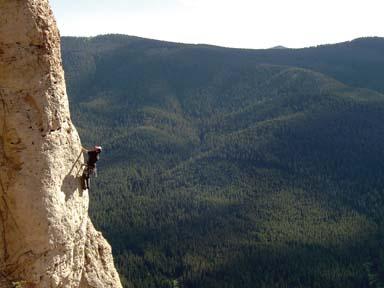Rock Climbing 101
Rock climbing is one of the greatest ways to get out and enjoy Montana's splendors in the summer. Plus, it's an absolute blast. The thrill of surmounting a sheer cliff that just moments before you swore was unclimbable is extremely empowering. Once you've done it for a bit, you'll start to notice rock outcroppings all over that you've walked right by for years. Rock climbing's popularity has exploded recently into a sport that no longer just appeals to hardcore adrenaline junkies. Today's gear and techniques have made the sport available to just about any level of athleticism. If you can climb a stairway or hang from a bar for over five seconds, you can climb. What's more, it's extremely safe when done correctly. What follows is a general introduction to the sport. To get the particulars (and you'll need them), I'd highly recommend reading How to Rock Climb by John Long, available at most outdoor stores in the area.
How It Works
Basically, rock climbing always involves at least two people. One is the climber and the other is the "belayer." They are connected by a rope that is tied to the climber and routed through an anchor in the rock, and back down to the belayer. This way, if the climber should lose his grip on the rock, the belayer can arrest his fall without injury. One of the easiest and most common ways to start climbing is by "top-roping." This means that the rope is anchored at the top of the climb (think of a pulley system with you as the load, except you're climbing up the rock instead of being hauled up). The belayer is just there to take up the slack and hold you if you slip. With a tight top-rope belay, a climber will seldom fall more than a foot.
As you gain skills and strength you will probably want to try "lead climbing." This is where you clip "quickdraws" into bolts drilled into the rock on the way up. In effect, each bolt becomes your topmost anchor. The bolts are usually spaced about 10-15 feet apart. This takes a lot more concentration since you'll be exposed to much longer falls.
Communication is extremely important in climbing, so much so that there's a set language used by all climbers to make perfectly clear what is meant. This assures that each climber knows exactly what the other needs. Any climbing book or an experienced partner will get you squared away on this.
The Gear
There's lots of gear and specialized devices for rock climbing, but starting out, you really only need a few things. The real key is finding someone you know and trust to go climbing with. If that draws a blank, there are several guides in the area (ask at the outdoor shops), and both MSU and the Spire offer classes.
If you're pretty sure you want to get into it, don't bother renting gear, just go ahead and get the stuff you'll like. These are the essentials:
—A comfortable harness. This should run about $50 and you shouldn't need many frills here.
—A chalk bag to dry your sweaty hands out ($5-$10). Attach it to the rear of your harness.
—A nice, big locking carabiner and belay device (about $40 for both). There are many different types, including automatic-locking types of both, but I'd just stick with something simple.
—The most personal and important choice is the climbing shoe. Take some time selecting the right pair. Lace up as many brands and models as you can, trying each one out on a climbing wall (Northern Lights have one). You won't know what features are best, but you'll know when one is decently comfortable, where your foot doesn't slip around in it. Size it pretty tight, but not painfully so. Expect to pay about $100-$150.
—If you have any cash left over, I�d recommend a helmet, which will cost about $50.
With just this gear, you can go climbing with anyone who has a rope and some experience. This list is all the personal stuff that every climber needs—with additional equipment, you usually only need one set for two people. Even as you progress beyond top-roping, there's no rush to drop another $300-$500 on equipment, because you can always partner up with someone who's got the advanced gear. After you get a bit of time on the rock, though, and want to be more self-sufficient (eventually, you'll get ribbed for too much free-loading), some of your next purchases might be:
—A rope. Quit borrowing your buddy's old fuzzy one. The most common is a 10.5mm x 60m, but many go with a 70-meter length nowadays.
—Quickdraws. These are sewn runners of webbing with carabiners at each end. One end hooks into the bolt, the other is what the rope clips into. If you're going to try lead-climbing, pick up about eight or ten of these.
—Camming devices (a.k.a. "cams"). For traditional climbing—using your own protection as you go, instead of pre-placed bolts—these expand into cracks and are pretty much essential. They run from about the width of your finger to over six inches wide. You can see which sizes you'll need by the size of the cracks you often run into or what you see on your partner's rack.
—Nuts (a.k.a. "rocks"). These are basically just wedge-shaped pieces of soft metal with a wire loop to attach the quickdraw. They jam into constricting cracks when weighted. Again, by the time you need these, you�ll know which sizes to get.
—More locking carabiners. For making anchors and when friends forget theirs.
—Webbing. Again for making anchors. Sometimes you just can't have enough webbing.
—A guidebook. When your partner doesn't know the area or just to get the scoop on new routes. Guidebooks will save you time scouting, prevent embarassing bail-outs, and introduce you to climbs you'd never know about otherwise.
Where To Go
All right, you've got your basic gear and a buddy, but where do you go? Consult your guidebook for exact directions, but first on the list has to be Practice Rock up Hyalite Canyon. This is a very popular spot with beautiful granite and lots of routes. Next is Bozeman Pass—it's just 10 minutes from town and has tons of short, pocketed limestone routes. As your skills progress, and you've got a good, experienced partner, you'll want to take a trip down Gallatin Canyon to its treasure trove of beautiful gneiss formations. There are many more, but half the fun is discovering them for yourself. On rainy days, you can keep in practice by hitting the Spire off N 19th.
Technique
Some people just look beautiful and lithe on the rock; they float from one move to the other effortlessly. What they have besides a pull-up regimen is technique. It usually comes from climbing with good climbers and watching their bodies. Some of the best advice I got when starting is this: Use Your Feet. Look for a handhold above your head, grab it. Then look down at where your foot is going and move it to that exact point in one smooth motion. Footwork is often where beginning climbers stumble the most, so keep an eye out for footholds and the handholds will appear.
Safety
Rock climbing is unique among outdoor adrenaline sports in that often the most respected climbers are the safest. In fact, good climbers take great pride in the safety of their anchors and vigilant belays. Darwin pays particular attention to activities like climbing, so keep focused. If there was just one cardinal rule in climbing, it'd be for the belayer—Never Take Your Brake Hand Off the Rope. Remember that and the rest you'll pick up by paying attention and watching others. Because of the burly equipment and strict safety protocols, modern rock climbing is much less prone to injuries than sports like mountain biking.
When you start climbing, one of the first things you'll notice is how thrilled and empowered you'll be sitting atop a finished climb. You accomplished something that moments ago seemed impossible. Often more mental than physical at first, climbing is about overcoming a base and natural fear, finding the right path up the rock, and learning to use your body as efficiently and deftly as possible. The beauty of climbing isn't that it'll get you in great shape and give you more confidence in your body, but that it ALL comes from within the climber. No amount of shiny, expensive gear will get you up the cliff. It's just you. It's the great equalizer endeavor, for any age or station in life.
Resources
The first book to buy for beginners is How to Rock Climb by John Long. Definitely a must-read if you're starting out. Second is Bozeman Rock Climbs by Bill Dockins, the local classic which covers the whole area and has lots of photos, which are key to finding routes. To find these guidebooks, and for more advice on where to go and what gear you'll need, check out these local shops:
Northern Lights Trading Company
1716 W. Babcock, Bozeman
586-2225
Grizzly Outfitters
Meadow Village, Big Sky
995-2939
Gallatin Alpine Sports
West Fork Mall, Big Sky
995-2313
Timber Trails
309 W. Park, Livingston
222-9550












